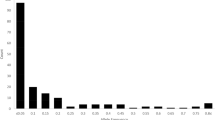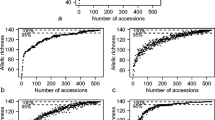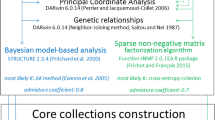Abstract
Genetic diversity among 5029 accessions representing a proposed Chinese wheat core collection was analyzed using 78 pairs of fluorescent microsatellite (SSR) primers mapped to 21 chromosomes. A stepwise hierarchical sampling strategy with priority based on 4×105 SSR data-points was used to construct a core collection from the 23090 initial collections. The core collection consisted of 1160 accessions, including 762 landraces, 348 modern varieties and 50 introduced varieties. The core accounts for 23.1% of the 5029 candidate core accessions and 5% of the 23090 initial collections, but retains 94.9% of alleles from the candidate collections and captures 91.5% of the genetic variation in the initial collections. These data indicate that it is possible to maintain genetic diversity in a core collection while retaining fewer accessions than the accepted standard, i.e., 10% of the initial collections captured more than 70% of their genetic diversity. Estimated genetic representation of the core constructed by preferred sampling (91.5%) is much higher than that by random sampling (79.8%). Both mean genetic richness and genetic diversity indices of the landraces were higher than those of the modern varieties in the core. Structure and principal coordinate analysis revealed that the landraces and the modern varieties were two relatively independent subpopulations. Strong genetic differentiation associated with ecological environments has occurred in the landraces, but was relatively weak in the modern cultivars. In addition, a mini-core collection was constructed, which consisted of 231 accessions with an estimated 70% representation of the genetic variation from the initial collections. The mini-core has been distributed to various research and breeding institutes for detailed phenotyping and breeding of genetic introgression lines.
Similar content being viewed by others
References
Dong Y S, Cao Y S, Zhang X Y, et al. Establishment of candidate core collections in Chinese common wheat germplasm. J Plant Genet Resour (in Chinese with English abstract), 2003, 4: 1–8
Tanksley S D, McCouch S R. Seed bank and molecular maps: Unlocking genetic potential from the wild. Science, 1997, 277: 1063–1066
Frankel O H. Genetic perspectives of germplasm conservation. In: Arber W, Limensee K, Peacock W J, et al, eds. Genetic Manipulation: Impact on Man and Society. Cambridge: Cambridge University Press, 1984. 161–170
Frankel O H, Brown A H D. Plant genetic resources today: A critical appraisal. In: Holden J H W, Williams J T, eds. Crop Genetic Resources: Conservation & Evaluation. London: George Allen & Urwin Ltd, 1984. 249–257
Brown A H D. Core collections: A practical approach to genetic resources management. Genome, 1989, 31: 818–824
Brown A H D. The case for core collections. In: Brown A H D, Frankel O H, Marshall D R, et al, eds. The Use of Plant Genetic Resources. Cambridge: Cambridge University Press, 1989. 136–156
Hamon S, van Stolen D H. Characterization and evaluation of okra. In: Brown A H D, Frankel O H, Marshall D R, et al, eds. The Use of Plant Genetic Resources. Cambridge: Cambridge University Press, 1989. 173–196
Corley H C, William F A. Evaluation of a core collection to identify resistance to late leaf spot in peanut. Crop Sci, 1995, 35: 1700–1702
Upadhyaya H D, Bramel P J, Singh S. Development of a chickpea core subset using geographic distribution and quantitative traits. Crop Sci, 2001, 41: 206–210
Hao C Y, Zhang X Y, Wang L F, et al. Genetic diversity and core collection evaluations in common wheat germplasm from the Northwestern Spring Wheat Region in China. Mol Breed, 2006, 17: 69–77
Hu J, Zhu J, Xu H M. Methods of constructing core collections by stepwise cluster with three sampling strategies based on genotypic values of crops. Theor Appl Genet, 2000, 101(1–2): 264–268
Wang J C, Hu J, Liu N N, et al. Investigation of combining plant genotypic values and molecular marker information for constructing core subsets. J Integr Plant Biol, 2006, 48: 1371–1378
Yonezawa K, Nomura T, Morishima H. Sampling strategies for use in stratified germplasm collections. In: Hodekin T, Brown A H D, van Hintum T J L, et al, eds. Core Collections of Plant Genetic Resources. Chichester: Wiley-Sayce Publication, 1995. 35–54
Brown A H D, Grace J P, Speer S S. Designation of a “core” collection of perennial Glycine. Soybean Genetics Newsletter, 1987, 14: 59–70
van Hintum T J L. Comparison of marker systems and construction of a core collection in a pedigree of European spring barley. Theor Appl Genet, 1994, 89: 991–997
Li Z C, Zhang H L, Zeng Y W, et al. Study on sampling schemes of core collection of local varieties of rice in Yunnan, China. Sci Agric Sin (in Chinese), 2000, 33(5): 1–7
Ellegren H. Microsatellites: Simple sequences with complex evolution. Nat Rev Genet, 2004, 5: 435–445
Balfourier F, Roussel V, Strelchenko P, et al. A worldwide bread wheat core collection arrayed in a 384-well plate. Theor Appl Genet, 2007, 114: 1265–1275
Zhang X Y, Pang B S, You G X, et al. Allelic variation and genetic diversity at Glu-1 loci in Chinese wheat (Triticum aestivum L.) germplasms. Sci Agric Sin (in Chinese), 2002, 35(11): 1302–1310
Zhang X Y, Tong Y P, You G X, et al. Hitchhiking effect mapping: A new approach for discovering agronomic important genes. Sci Agric Sin (in Chinese), 2006, 39(8): 1526–1535
Zhuang Q S. Chinese Wheat Improvement and Pedigree Analysis (in Chinese). Beijing: Agricultural Press, 2003
Institute of Crop Germplasm Resources, CAAS. Chinese Wheat Genetic Resource Catalogs. Beijing: China Agriculture Press, 1995.
Hao C Y, Wang L F, Dong Y C, et al. Comparison of fluorescence and silver-staining detection systems of microsatellite markers. Acta Agron Sin (in Chinese), 2005, 31: 144–149
Röder M S, Korzun V, Wendehake K, et al. A microsatellite map of wheat. Genetics, 1998, 149: 2007–2023
Zhang X Y, Li C W, Wang L F, et al. An estimation of the minimum number of SSR alleles needed to reveal genetic relationships in wheat varieties. I. Information from large-scale planted varieties and corner-stone breeding parents in Chinese wheat improvement and production. Theor Appl Genet, 2002, 106: 112–117
You G X, Zhang X Y, Wang L F. An estimation of the minimum number of SSR loci needed to reveal genetic relationships in wheat varieties: Information from 96 random samples with maximized genetic diversity. Mol Breed, 2004, 14: 397–406
Nei M. Analysis of gene diversity in subdivided populations. Proc Natl Acad Sci USA, 1973, 70: 3321–3323
Hu J, Xu H M, Zhu J. A method of constructing core collection reserving special germplasm materials. J Biomathemat, 2001, 16(3): 348–352
Rohlf F J. NTSYS-pc: Numerical taxonomy and multivariate analysis system, Version 2.1. NY: Exeter Software, 2000
Pritchard J K, Stephens M, Donnelly P. Inference of population structure using multilocus genotype data. Genetics, 2000, 155: 945–959
Spagonletti Z P L, Qualset C O. Evaluation of five strategies for obtaining a core subset from a large genetic resource collection of durum wheat. Theor Appl Genet, 1993, 87: 295–304
Hao C Y, Wang L F, Zhang X Y, et al. Genetic diversity in Chinese modern wheat varieties revealed by microsatellite markers. Sci China Ser C-Life Sci, 2006, 49: 218–226
Peleman, J D, van der Voort R. Breeding by design. Trends Plant Sci, 2003, 8: 330–334
Jia J Z. Applications of theories and approaches of plant genomics. Revi China Agricult Sci Technol (in Chinese), 1999, 2: 41–45
He G M, Luo X J, Tian F, et al. Haplotype variation in structure and expression of a gene cluster associated with a quantitative trait locus for improved yield in rice. Genome Res, 2006, 16: 618–626
Author information
Authors and Affiliations
Corresponding author
Additional information
Supported by the National Basic Research Program of China (Grant Nos. G19980202 and 2004CB117202)
About this article
Cite this article
Hao, C., Dong, Y., Wang, L. et al. Genetic diversity and construction of core collection in Chinese wheat genetic resources. Chin. Sci. Bull. 53, 1518–1526 (2008). https://doi.org/10.1007/s11434-008-0212-x
Received:
Accepted:
Published:
Issue Date:
DOI: https://doi.org/10.1007/s11434-008-0212-x




